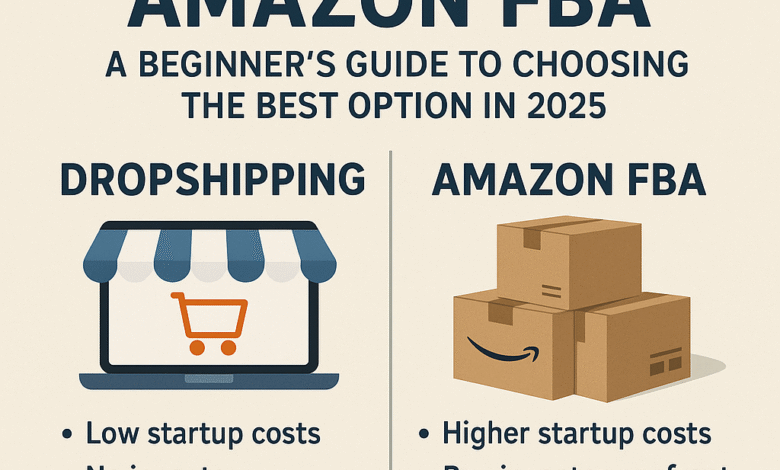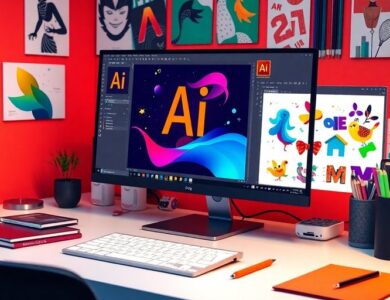Dropshipping vs Amazon FBA: A Beginner’s Guide to Choosing the Best Option in 2025

If you’re thinking about starting an online business in 2025, you’ve probably heard about dropshipping and Amazon FBA. Both options have their own sets of perks and challenges, which can be confusing for newcomers. This guide aims to break down the differences between these two popular e-commerce models, helping you make a more informed choice about which one might fit your needs better. Whether you want to keep costs low or tap into Amazon’s vast customer base, understanding the basics is key.
Key Takeaways
- Dropshipping is usually easier to start with less upfront investment.
- Amazon FBA can lead to higher profits but requires more capital and commitment.
- Both models have their own risks and rewards; assess your comfort level before deciding.
- Consider your long-term goals when choosing between dropshipping and Amazon FBA.
- Marketing strategies differ significantly between the two models, so plan accordingly.
Understanding Dropshipping and Amazon FBA

What Is Dropshipping?
Okay, so dropshipping. Basically, it’s like being a store owner without actually having to own a store, or, you know, inventory. You’re more like a middleman. Someone buys something from your site, and then you tell your supplier to ship it directly to the customer. You never even see the product. It sounds easy, and in some ways it is, but there are definitely things to consider. You’re basically curating products and handling the marketing, but someone else is doing all the heavy lifting of fulfillment.
What Is Amazon FBA?
Amazon FBA, or Fulfillment by Amazon, is a different beast altogether. With FBA, you send your products to Amazon’s warehouses. When someone buys your stuff on Amazon, Amazon handles the picking, packing, shipping, and even customer service. It’s pretty hands-off once your inventory is at Amazon. The big advantage is access to Amazon’s massive customer base and established logistics network. But, of course, there are fees involved, and managing your inventory so you don’t run out (or get stuck with too much) is key.
Key Differences Between Dropshipping and Amazon FBA
So, what’s the real difference? Well, it boils down to a few things:
- Inventory: Dropshipping = no inventory. FBA = you own the inventory, and Amazon stores it.
- Fulfillment: Dropshipping = supplier ships. FBA = Amazon ships.
- Customer Service: Dropshipping = you often handle it (unless your supplier offers support). FBA = Amazon handles a lot of it.
- Startup Costs: Dropshipping = generally lower. FBA = higher, because you have to buy inventory upfront.
- Branding: Dropshipping = more control over your brand. FBA = you’re selling on Amazon’s platform, so less branding control.
Choosing between dropshipping and Amazon FBA really depends on your goals, budget, and how much control you want over your business. Both models have their pros and cons, and what works for one person might not work for another. It’s all about finding the right fit for you and your products.
Cost Considerations for Beginners
Starting an e-commerce business can be exciting, but understanding the costs involved is super important, especially when choosing between dropshipping and Amazon FBA. Let’s break down the initial and ongoing expenses for each model to help you make an informed decision.
Initial Investment for Dropshipping
Dropshipping is often touted as the more budget-friendly option, and for good reason. You don’t need to invest heavily in inventory upfront, which significantly lowers the barrier to entry. However, there are still costs to consider:
- Website platform (e.g., Shopify, WooCommerce): $29 – $299/month. This is where you’ll host your online store.
- Product research tools: $20 – $50/month. These tools help you find trending and profitable products.
- Initial marketing budget: $500 – $1,000. This covers advertising, social media, and other promotional activities.
- Domain name: Around $10-$20 per year.
Dropshipping’s appeal lies in its low initial investment, allowing entrepreneurs to start with minimal capital. However, it’s important to factor in ongoing marketing costs and potential expenses related to returns and customer service.
Initial Investment for Amazon FBA
Amazon FBA requires a more substantial upfront investment compared to dropshipping. You’ll need to purchase inventory, ship it to Amazon’s warehouses, and cover other initial setup costs. A typical product launch might set you back:
- Initial inventory: $2,000 – $5,000 (minimum). This is the biggest expense, as you need to buy products in bulk.
- Amazon seller account: $39.99/month. This is the fee for a professional seller account.
- Product research tools: $29 – $99/month. These tools help you identify profitable products on Amazon.
- Sample products and testing: $200 – $500. It’s important to test product quality before investing in a large quantity.
- Photography and listing creation: $300 – $1,000. High-quality images and compelling product descriptions are essential for success.
Ongoing Costs and Fees
Both dropshipping and Amazon FBA involve ongoing costs that can impact your profitability. Here’s a breakdown of what to expect:
Dropshipping:
- Marketing and advertising: This will likely be your biggest ongoing expense, as you need to constantly drive traffic to your store.
- Transaction fees: Payment processors like PayPal charge fees per transaction.
- Customer service: Handling returns, refunds, and customer inquiries can be time-consuming and costly.
Amazon FBA:
- Storage fees: Amazon charges fees for storing your products in their warehouses. These fees vary depending on the size and weight of your items.
- Fulfillment fees: Amazon charges fees for picking, packing, and shipping your products to customers.
- Advertising costs: Running PPC campaigns on Amazon can help you increase product visibility and sales.
| Cost Type | Dropshipping | Amazon FBA |
|---|---|---|
| Initial Investment | Lower | Higher |
| Inventory Costs | None upfront | Significant upfront |
| Marketing Costs | High ongoing | Moderate ongoing |
| Storage Fees | None | Yes |
| Fulfillment Fees | Handled by supplier | Yes |
Choosing between dropshipping and Amazon FBA depends on your budget, risk tolerance, and business goals. Dropshipping offers a lower barrier to entry, while Amazon FBA provides access to a large customer base and streamlined fulfillment services. Consider all the costs involved before making a decision.
Pros and Cons of Dropshipping
Advantages of Dropshipping
Dropshipping offers some compelling advantages, especially for those just starting out in e-commerce. One of the biggest perks is the low initial investment. You don’t need to sink a ton of cash into inventory, which significantly lowers the barrier to entry. This means you can start a business without a huge financial risk.
Here’s a quick rundown of the benefits:
- Flexibility: You can run your business from anywhere with an internet connection.
- Wide Product Selection: You can offer a wide variety of products without holding any inventory.
- Reduced Risk: Since you only pay for products when a customer buys them, you avoid the risk of being stuck with unsold items.
Dropshipping is great because it lets you test different products and niches without committing a lot of money upfront. This is super helpful when you’re trying to figure out what sells and what doesn’t. It’s like having a low-stakes testing ground for your business ideas.
Disadvantages of Dropshipping
While dropshipping has its perks, it’s not without its downsides. One of the most significant challenges is lower profit margins. Since you’re not buying in bulk, you don’t get the same discounts as retailers who hold their own inventory. This can make it tough to compete on price and still make a decent profit. Another issue is less control over the order fulfillment process. You’re relying on a third-party supplier to ship your products, which means you have less control over shipping times, product quality, and customer service. This can lead to customer dissatisfaction and damage your brand’s reputation.
Here are some of the cons:
- Inventory Management: Relying on suppliers for inventory can lead to stock issues.
- Shipping Complexities: Managing shipping when products come from different suppliers can be a headache.
- Competition: The low barrier to entry means there’s a lot of competition in the dropshipping market.
Ideal Scenarios for Dropshipping
Dropshipping isn’t a one-size-fits-all solution, but it works well in certain situations. It’s a great option for entrepreneurs who are just starting out and want to test the waters of e-commerce without a huge financial commitment. It’s also a good fit for businesses that want to offer a wide range of products without investing in inventory. For example, if you’re selling niche products or seasonal items, dropshipping can be a cost-effective way to manage your inventory. Dropshipping can be a good way to diversify your product offerings without the overhead of managing inventory. Ultimately, the key is to carefully weigh the pros and cons and determine if dropshipping aligns with your business goals and risk tolerance.
Pros and Cons of Amazon FBA
Advantages of Amazon FBA
Amazon FBA (Fulfillment by Amazon) can be a game-changer, but it’s not without its drawbacks. One of the biggest advantages is the sheer reach you get. Amazon boasts a massive customer base, and FBA gives you instant access to it.
Here’s a breakdown of the good stuff:
- Focus and Scale. Amazon handles the nitty-gritty like packing, shipping, and customer service, freeing you up to concentrate on growing your business.
- Huge Customer Base. Tap into Amazon’s vast network of shoppers, instantly expanding your potential market.
- Fast Delivery. FBA products are eligible for Amazon Prime’s fast, free shipping, a major draw for customers.
- Customer Service and Returns. Amazon takes care of customer service inquiries and manages returns, saving you time and hassle.
- Brand Recognition. Leverage Amazon’s trusted brand to boost customer confidence in your products.
Disadvantages of Amazon FBA
Of course, it’s not all sunshine and rainbows. FBA comes with its own set of challenges. The biggest hurdle for many is the cost. You’ve got to factor in storage fees, fulfillment fees, and other charges that can eat into your profits.
Here’s a look at the downsides:
- Upfront Costs. You need to purchase inventory upfront, which can be a significant investment.
- Storage Fees. Amazon charges fees for storing your products in their warehouses, and these can fluctuate depending on the time of year and the space your inventory occupies.
- Fulfillment Fees. You’ll pay fees for Amazon to pick, pack, and ship your orders.
- Less Control. You’re handing over a big chunk of your business to Amazon, which means you have less direct control over the fulfillment process.
- Complex Rules. Amazon has a lot of rules and regulations that you need to follow, and it can be tough to keep up with them all.
Amazon FBA can be a great way to scale your business, but it’s important to weigh the costs and benefits carefully before jumping in. Make sure you understand the fees, the rules, and the potential risks before you commit.
Ideal Scenarios for Amazon FBA
So, when does FBA make sense? It’s a good fit if:
- You have products that are in high demand and sell quickly.
- You want to focus on marketing and product development, rather than fulfillment.
- You’re comfortable with Amazon’s fees and regulations.
- You want to take advantage of Amazon Prime’s fast shipping.
- You’re looking to scale your business quickly and efficiently.
If you’re just starting out or have a limited budget, dropshipping might be a better option. But if you’re ready to invest in inventory and want to leverage Amazon’s vast resources, FBA could be the way to go.
Choosing the Right Model for Your Business
Okay, so you’ve looked at dropshipping and Amazon FBA. Now, how do you actually pick one? It’s not a one-size-fits-all thing. What works for your neighbor might be a disaster for you. It really boils down to what you can afford, how much risk you’re okay with, and where you see your business going in the future.
Assessing Your Budget
Let’s be real, money talks. Your budget is a major factor in deciding between dropshipping and Amazon FBA. Dropshipping is often seen as the cheaper way to start because you don’t have to buy inventory upfront. But don’t be fooled, marketing costs can add up fast. With FBA, you’ll need money for inventory, but you might save on marketing since you’re on Amazon’s platform.
Evaluating Your Risk Tolerance
How much are you willing to lose? Dropshipping has less financial risk since you’re not stuck with unsold products. However, you’re taking a risk on product quality and shipping times, which you don’t control. FBA means you could be sitting on a pile of products that just won’t sell. It’s a balancing act. Think about how much stress you can handle. If the thought of losing a bunch of money keeps you up at night, maybe start with dropshipping. If you’re okay with a bigger investment for potentially bigger returns, FBA might be your thing. Remember to find paid survey sites to supplement your income while you’re starting your business.
Long-Term Business Goals
Where do you see yourself in five years? Are you trying to build a brand, or just make some extra cash? Dropshipping can be a good way to test out different products and see what sells, but it’s harder to build a brand when you don’t control the whole process. FBA gives you more control over branding and customer experience, which can be important for long-term growth.
Think about what you want your business to become. Do you want to sell it someday? Do you want to create your own product line? Your long-term goals will help you decide which model is the best fit. If you want to build a recognizable brand, FBA might be the better choice, even with the higher initial investment.
Marketing Strategies for Each Model
Alright, so you’ve picked your e-commerce poison – dropshipping or Amazon FBA. Now comes the fun part: actually getting people to buy your stuff. Marketing isn’t just an afterthought; it’s the engine that drives sales. Let’s break down how to approach marketing for each model.
Marketing for Dropshipping
Dropshipping marketing is all about speed and agility. You’re not sitting on inventory, so you can test different products and niches quickly. Here’s the lowdown:
- Social Media Blitz: Platforms like TikTok, Instagram, and Facebook are your best friends. Run targeted ads showcasing your products. Short, engaging videos work wonders. Don’t forget influencer marketing – find relevant influencers in your niche to promote your products.
- SEO is Still King: Even with dropshipping, search engine optimization matters. Optimize your product descriptions and website content for relevant keywords. This helps people find you organically when they’re searching for specific items.
- Email Marketing: Build an email list and nurture it. Offer discounts, run promotions, and keep your subscribers engaged. A well-crafted email campaign can drive repeat business.
Dropshipping marketing requires constant testing and optimization. Don’t be afraid to experiment with different strategies and see what works best for your audience. Track your results closely and adjust your approach as needed.
Marketing for Amazon FBA
Amazon FBA marketing is a different beast. You’re working within the Amazon ecosystem, which has its own set of rules and best practices.
- Amazon PPC (Pay-Per-Click): This is non-negotiable. Master Amazon’s advertising platform to get your products in front of potential buyers. Optimize your product listings with relevant keywords and high-quality images. Amazon PPC Tool can help you automate and optimize your campaigns.
- Amazon SEO: Just like with dropshipping, SEO is crucial. Optimize your product titles, descriptions, and bullet points for relevant keywords. The higher you rank in Amazon’s search results, the more sales you’ll get.
- Reviews are Gold: Encourage your customers to leave reviews. Positive reviews build trust and social proof, which can significantly boost your sales. Consider using a tool to automate review requests.
Building a Brand Presence
Whether you’re dropshipping or using Amazon FBA, building a brand is essential for long-term success. Here’s how:
- Consistent Branding: Use the same logo, colors, and messaging across all your marketing channels. This helps create a cohesive brand identity that customers will recognize.
- Focus on Customer Service: Provide excellent customer service. Respond to inquiries promptly and resolve issues quickly. Happy customers are more likely to become repeat customers and brand advocates.
- Create Content: Create valuable content that educates, entertains, or inspires your target audience. This could be blog posts, videos, social media updates, or anything else that resonates with your customers. Content marketing helps build trust and authority, which can lead to increased sales.
Future Trends in E-Commerce

Emerging Trends for Dropshipping
Dropshipping is changing fast. One thing I’ve noticed is that niche specialization is becoming super important. You can’t just sell everything; you need to find a specific area and really own it. Also, I’m seeing more people focus on building actual brands around their dropshipping stores, instead of just treating it like a quick way to make money. It’s all about creating a real connection with customers.
- Niche specialization
- Brand building
- Focus on customer experience
Emerging Trends for Amazon FBA
Amazon FBA is also seeing some big shifts. AI is becoming a huge deal, helping with everything from figuring out what products to sell to optimizing prices in real-time. I’ve also read about more sellers using tools to predict inventory needs, which is a game-changer. Plus, with Amazon’s advertising costs always going up, finding creative ways to stand out is more important than ever.
- AI-powered optimization
- Inventory prediction tools
- Creative marketing strategies
Predictions for E-Commerce in 2025
E-commerce in 2025 is going to be all about personalization and automation. I think we’ll see more AI helping to create custom shopping experiences for each customer. Also, sustainability is going to be a bigger deal, with more people wanting to buy from companies that are eco-friendly. And of course, mobile shopping will continue to grow, so making sure your site is mobile-friendly is a must.
E-commerce is not waiting. The best time to start was yesterday. The second best time is now.
Here’s a quick look at what I expect to see:
- Increased personalization through AI
- Greater emphasis on sustainability
- Continued growth of mobile shopping
Final Thoughts
So, there you have it! Both Amazon FBA and dropshipping have their perks and downsides. If you’re just starting out and want to keep things simple and low-cost, dropshipping might be your best bet. You can test the waters without spending a ton of cash on inventory. But if you’re ready to invest some money and want to tap into Amazon’s huge customer base, then FBA could be the way to go. It’s all about what fits your style and goals. Take your time, weigh your options, and choose what feels right for you. Good luck with your e-commerce journey!
Frequently Asked Questions
What is dropshipping?
Dropshipping is a way to sell products without keeping any stock. When a customer buys something from your store, you order it from a supplier who ships it directly to the customer.
What does Amazon FBA mean?
Amazon FBA stands for Fulfillment by Amazon. It means you send your products to Amazon’s warehouse, and they take care of storage, shipping, and customer service for you.
Which option is cheaper to start: dropshipping or Amazon FBA?
Dropshipping is usually cheaper to start because you don’t need to buy inventory upfront. You only pay for products after you make a sale.
What are the main advantages of dropshipping?
The biggest advantages of dropshipping are low startup costs, no need to manage inventory, and the ability to easily change products or niches.
What are the downsides of using Amazon FBA?
Some downsides of Amazon FBA include higher initial costs, storage fees, and less control over your brand and customer relationships.
How do I choose between dropshipping and Amazon FBA?
To decide, think about your budget, how much risk you want to take, and your long-term business goals. Dropshipping is great for beginners, while Amazon FBA can be better for those ready to invest more.



